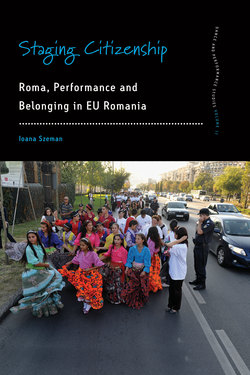Читать книгу Staging Citizenship - Ioana Szeman - Страница 9
Performance and the Citizenship Gap
ОглавлениеIn this book I focus on performances by and about Roma – in the media, onstage, in schools and at international and local festivals – in relation to the citizenship gap and to symbolic and tacit understandings of who is included in the nation and the collective ‘we’. I show how these representations influence the perception and racialization of Roma among non-Roma, including in everyday encounters, cultural events, and social programmes organized by state institutions and NGOs. I examine the citizenship gap in the everyday lives of Pod residents, and the ways they resist that citizenship gap through dance and performance, which I analyse as expressions of cultural citizenship. I draw out the tensions between the state’s definitions and recognition of the Roma on the one hand, and Roma activists and NGOs who resist or inadvertently accept the citizenship gap on the other. I analyse: the newly successful Romanian television soaps Gypsy Heart (Inimă de Ţigan), The Queen (Regina) and State of Romania (State de România), in which non-Roma actors play Roma characters; reality shows on Romanian television, such as Clejanii, which features famous Roma musicians; and music and dance performances, including manele, a controversial and extremely popular music genre played almost exclusively by Roma musicians in Romania. I also discuss internationally acclaimed Roma artists and young amateur performers in Pod, the very few television programmes by Roma in Romania (such as the weekly programme Roma Caravan – Caravana Romilor) and the presence of Roma activists on mainstream Romanian talk shows and television programmes.
This book analyses performances as expressions of belonging and cultural citizenship for Roma, transmitted across generations through what Diana Taylor (2003) calls the ‘repertoire’, and absent from institutionalized forms of culture in Romania. At the same time, the association between Roma and performance, especially music performance, has been a staple of perceptions and stereotypes of Roma (Okely 1983; Stewart 1997; Lemon 2000a; Silverman 2012). For centuries, Roma musicians in Russia and the countries of East Central Europe were considered mere vehicles of the genius of those nations, and as lacking a culture of their own. Roma were excluded from national culture and folklore in Romania, and Roma musicians’ contribution was seen to be merely the transmission of Romanian folklore. The visibility of Roma as the exotic Other onstage and in works of literature and art by non-Roma was accompanied by constant monitoring and repression by the police and authorities across centuries.
The current visibility of Roma onstage and in the media relies upon the recycling of lucrative old stereotypes about Roma (see Silverman 2012; Imre 2009; Imre and Tremlett 2011) and, at the same time, I argue, it creates a Roma counterpublic. Like Trehan (2009), I see the Roma counterpublic as subaltern, following Nancy Fraser (1992)11: the Roma counterpublic’s existence is denied by the state’s equation of citizenship to Romanian ethnicity. However, I focus here on the transformative potential of counterpublics, conveyed by Michael Warner’s definition, as ‘spaces of circulation in which it is hoped that the poesis of scene making will be transformative, not replicative merely’ (Warner 2002, 88). Viewed in this way, Roma counterpublics, which resist the citizenship gap and challenge the hegemony of ethnic nationalism,12 have the potential to include non-Roma and Roma alike. Through performances analysed in this book, Roma articulate belonging to Romania, imagining Romania as a pluralistic, diverse nation and proposing alternative views of citizenship that do not equate the nation with an ethnic group. While I identify these counterpublics as Roma, non-Roma may share the same views, just as the hegemonic public can be both non-Roma and Roma. For example, in the reality show Clejanii, Viorica identifies herself as a hard-working woman who does not conform to commercially promoted standards of feminine beauty that objectify women. She appeals to a counterpublic who understand and appreciate the labour behind her successful musical performances as a Roma artist.
Another example of performance of citizenship addressing a Roma counterpublic is the August 2010 edition of the television programme Roma Caravan, dedicated to the expulsions of Roma from France. In this programme, Daniel Vasile, vice-president of the Roma Party for Europe, and George Răducanu, Roma activist, accused both French and Romanian governments of racism and criticized the treatment of Roma Romanian citizens as second-class citizens. They spoke to a Roma counterpublic and pointed out that the forceful expulsions and evictions of Roma in France and Romania, respectively, reflected the French and Romanian governments’ similar attitudes towards Roma. This was one of the rare instances where unequivocal criticism of the expulsions was broadcast on Romanian television and media in general.
